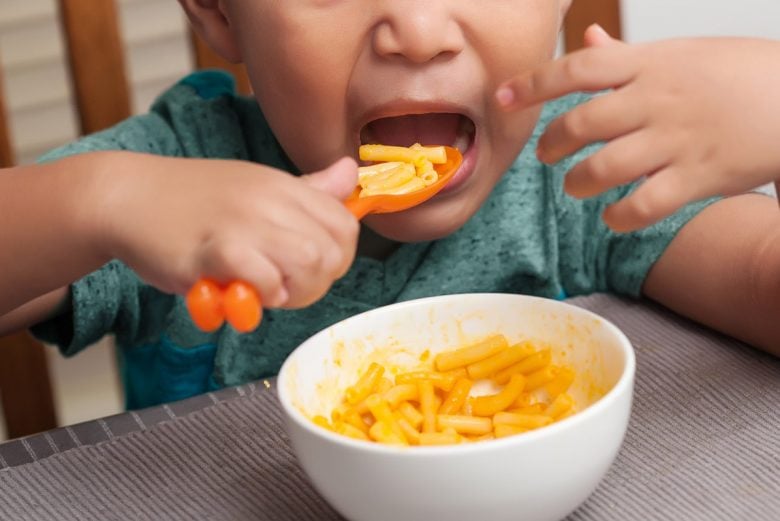
For the child who is always on the go.
Does your determined child resist sitting down to eat? Or do they love eating so much that they inhale their food too fast?
In this episode, Carol and Anne share common tendencies of Type 3 children for mealtime and snacks. You’ll get insight into how your child’s naturally swift movement applies to eating, so you can support them.
This episode’s Parenting Practice
Listen to this week’s episode and notice which tip is true to your Type 3 child (or yourself if you’re a Type 3). Then practice that tip throughout the week to help your child . See what a difference it makes!
Transcript of podcast episode
Carol: Welcome to The Child Whisperer podcast. I’m your host, Carol Tuttle, author of the best-selling parenting book, The Child Whisperer. I’m with my co-host, Anne Tuttle Brown. Today, we’re looking at the eating tendencies for your Type 3 child. And as you know, and we hope you know because you’ve read The Child Whisper, that this is the Determined Child. They have a physical connection with the world, their movement is more…has an intensity, an assertiveness to it. They have a heavier quality, a substance to who they are, and they move swiftly. And these same movements expressed their eating tendencies. So what are our two keywords we’re going to focus on today as we answer these questions, Anne?Anne: Swift and substance. And substance kind of refers to what they’re looking to get when they eat. They like hearty, substantial foods, and also like an active quality along with that swift. So we’re going to ask a couple questions, and then we’ll talk about the Type 3 parent tendency as well. So what is the Type 3 child’s conduct like at the table? And what’s that experience at mealtime?
Carol: Well, they’re going to be the quickest to finish their food. So swift applies there. Type 3s are known to eat swiftly. In fact, I make it a point now, as a Type 3, to not be doing anything else when I’m eating. So I really focus in on the fact that I’m chewing it…
Anne: Is that a tendency to distract yourself while you’re eating?
Carol: Yeah. Well, you know, the whole saying that…we’re multi-taskers. So looking at, yeah, a child engaged in something else while they’re eating, you tend to eat faster, not chew your food enough, and can just…sort of like the whole idea of inhaling your meal. And as you take away other activities, I think the family mealtime, the engagement there is supportive. But let’s say if they’re eating breakfast or their lunch or whatever in a solo environment that they’re not doing other things. So they really recognize to take up just a little more time to eat because we’ll just eat too quickly. And it’s not your best for your digestive system. So I know I have that tendency. I see Type 3 children have that tendency.
Ann: My Type 3 three-year-old will take giant bites. And I’m like, “Whoa, whoa, whoa buddy, like, let’s cut that in half. Like, take a smaller bite, chew your food longer,” and he’ll respond to that, you know, “Okay.”
Carol: Your husband’s the fastest Type 3 eater I’ve ever seen. Like, he’s beat every other Type 3 out there.
Anne: And I’m not a fast eater, so it’s tricky. Like, don’t…
Carol: He chews fast.
Anne: Yeah. And he loves food, but it’s like, “Eat, get it done, let’s move on.” And I’m like, “You sit down and you enjoy this meal with me.” I know you’re done, but when we share food, I have to, like, slice a line down the middle, because I’ll get nervous. Like, you’re going to eat it faster than me. Along with that swiftness, when they get hungry, they can be very demanding. Like, get it now.
Carol: Yeah, we are familiar with the term “hangry,” that’s definitely Type 3. I think Type 3s and Type 4s, that can play out with the hangry, meaning they’re more intense. When they’re not…when they need calories, they either need to be hydrated or they need some fuel.
Anne: There have been so many times with my Type 3 kids where I’m like correcting or disciplining, and I’m like, “No, you’re just hungry. Let’s get food. Let’s get this taken care of.” Even the other night, Katie was so weepy and just complaining about things. And after dinner, her mood totally changed. I’m like, “Oh, you were hungry.”
Carol: Yeah, I think those…hydration, do they need fuel, food, or sleep? With an imbalance of any of those or poor nutrition, they’re going to be more irritable and easily agitated. That determination comes out, and that aggression comes out as irritability and being difficult to interact with.
Anne: And I’ve shared that we have, you know, designated mealtimes and snack time. And so when my kids get hungry before that, I’ll let them choose either, you know, carrots or nuts, something just really healthy. If they really are hungry, they’ll go for that. And there are times where my 3-year-old Type 3 will say, “Well, can I have a banana?” Like, “Yeah, okay, you really are,” and he’ll scarf down that banana and it’s, you know, an hour before dinner and he just needed a little something.
Carol: Yeah, as you see in small children, the cycles of their appetite when they’re in a growing phase, they just need more calories, they need more food consumption, where then they’ll have a lighter appetite. You know, that’s just really typical for all children, but especially Type 3, I think, you’ll see. And depending on the activities of the day, if they’ve had a very physical day, they’ve burned a lot of calories, they need a little more to eat, you know, and they might not always stop to take…As the older they get, you know, Katie’s all…your 9-year-old Type 3, she’s always had a great affection for food. She enjoys food, she…
Anne: Yeah, she’s been very adventurous with her food, too. She’s tried a lot of different options.
Carol: So she isn’t one of those kids that doesn’t want to stop to eat because she’s busy. Seems like that has…but that can be an issue for some Type 3 children that they just stay busy and you need to make sure that they’re…
Anne: Yeah, there have been times with my littler one where it’s definitely like, “I want to keep doing this.” And once I just force them to the table, it’s like, “Oh, okay, I actually want to eat right now, too.”
Carol: That can play out with potty training also.
Anne: Totally. Yep, I was thinking the same thing.
Carol: Like, “No, no, I don’t want to take time to go to the bathroom.”
Anne: You know, they are such swift eaters that at dinnertime when you’re all sitting together as a family, and it can be like, “Okay, I’m done,” and head out. And so keeping them engaged, you know, with conversation.
Carol: Yeah. How do you keep your Type 3 three-year-old engaged? Because he’s definitely pretty…he’s done. He’s like, “I’m done. Got to go.”
Anne: Yeah, it’s something that he’s grown into. When he had a little booster chair, I would buckle him up, say, like, “You need to stay, we’re not done yet,” you know, “a few more minutes, like, stay here.” And that was a priority for me, to create a dynamic, as a family, of sitting together for at least 30 minutes at dinner time and enjoying each other’s company and enjoying the meal. And so there were times where, you know, if he’d finished his meal, and I’d bring over a little toy for him, or I’d let him sit on my lap, or, you know, kind of to just extend that last little bit that, you know, I was trying to build up to, and he’s done better now that he’s getting older.
And also, there are times where he’s thought he was done. Like, “I’m all done, I want a move…” I’m like, “No, take a few more bites,” and then he’ll engage again, and he’ll actually end up eating twice as much. And it’s kind of just that reminders, or just redirections, where like, you still had room in your belly, you wanted more food, but you thought you wanted to move on, especially when they’re young. But ultimately, I’m trying to help him listen to his body.
Carol: You’re teaching that mealtime just isn’t about finishing the food on your plate. It’s an experience.
Anne: That’s dinnertime, for sure.
Carol: Yeah. Yeah, that’s what I’m saying, your dinner…you’ve crafted that to be an experience that’s more than just eating a meal from a plate. We see posts like this all the time on The Child Whisperer Facebook group, the 2-year-old pushing the stool up to the counter or cabinet and preparing their own breakfast, and getting their cereal. So they don’t always ask. Have you experienced this with your Type 3 children?
Anne: Yeah. And I think it can be a great asset if…Like, this morning, I went to the gym early and I called home to see how things were going on my way to work, and Katie said, “I got up, I got my lunch ready.” And she’s a third-grader, you know, so like, she’s taken the responsibility. And we’ve taught her what she needs to do. And she’s a great helper in the kitchen as well. Sometimes it slows me down, you know, just because my kids are learning, but I do like to engage them in the kitchen, especially with the Type 3s, they love to, you know, see the results and get their hands into it.
Carol: Yeah, cooking was that for me as a kid. I’d come home from grade school, I remember being in fifth and sixth grade and I would read cookbooks that had pictures. And I was really…that whole process of a project, hands-on, getting that result just always was a medium for me to express that as a Type 3 with food. The flip side of that is they’re eating things you don’t want them to, they’re getting in and snacking more, which throws off their meal eating because your very Determined Type 3 children are just, you know, eating when they want and maybe things you don’t want them eating at those times. The best story I have about eating…I just have to tell this. A former fitness trainer I worked with, her father-in-law was Type 3. And he was at their home and she had prepared a birthday cake for one of the kids. And it was being saved for the party. He went in and just cut himself a slice.
Anne: Oh my gosh.
Carol: Yeah, like, “You’re kidding, right?” I mean, that’s just really taking matters into your own hands. Like, okay.
Anne: Got her name written on it and everything, he’s just like, “No one will know, I’ll just…”
Carol: All right, when the Type 3 child…now this has become an issue. It’s a problem. It’s like, “Stop sneaking food into your bedroom.” Finding stuff in their beds, you know.
Anne: That result of a parent that always said no or the result of a parent that didn’t have any boundaries.
Carol: Yeah, right. But, you know, they find food that they’ve snuck, and yeah, they want to eat, if they are into candy and sweets, and they’re prohibited from eating that. And they’re finding a way around it.
Anne: And we talked a little bit about this in the Type 1 is creating that flexibility within the boundaries you’ve set. “So it’s snack time, what do you want to eat?” Or, “Yeah, you can have some chips before you go to bed,” or just creating…or breakfast, like what are some, you know, breakfast options that they like that you can, you know, add variety, and eating out, you know, is always a fun thing to look forward to. That just changes it up, mixes it up, which I think is great for Type 3s.
Carol: And if there’s honestly something you just don’t want your kids eating and sneaking, don’t buy it. You’ve brought whatever’s in the home.
Anne: Or if it’s something you want, put it in your closet where they’re not expecting to find food.
Carol: That will be a test, you can experiment with that.
Anne: I’ve had to come up with some good hiding spots, mostly for my Type 3 husband.
Carol: How funny, the Type 3s are all scouting the house.
Anne: Yeah, they’re like…because you know he’ll…I like to a get like a little, you know, sweet snack or something. He’ll eat it all and I was like, “That was going to last me three months.” I’ll just take little bits.
Carol: I actually have the opposite. It’s funny because I’m the Type 3…
Anne: Maybe it’s a male thing.
Carol: …in our house that will make something last because I just don’t eat a lot of sweet stuff when I eat it. And it’s my Type 2 husband that will enjoy it so much, he won’t stop.
Anne: I’ve noticed in Type 3s, too, they like heartier foods. Katie, right now, she’s a 9-year-old Type 3, her favorite food is steak.
Carol: Oh, is that right? She’s into protein.
Anne: Yeah, really drawn…she always has loved eggs. Just more hearty things.
Carol: You mentioned that your Type 2 likes those what we traditionally call comfort…you know, pancakes, warm, soft foods, you know, does she like those?
Anne: Yeah, but her preference has always been like chips, crunchy…
Carol: Yeah, something like nuts and texture, more texture.
Anne: What are other Type 3 traditional, you know, foods, snack foods, like rich things too, like a rich…She does like chocolate. You like richer things, don’t you?
Carol: Yeah.
Anne: If you’re craving something.
Carol: And not overly sweet.
Woman’s voice: We’ve got more “Child Whisperer” coming up right after this brief message. Knowing your Type and your child’s Type changes everything, doesn’t it? It helps you to understand one another better. It can help your outside too. When you wear clothes that express your Type, you feel better, you look better, and people understand you more easily, including your kids. Carol Tuttle created the Dressing Your Truth program to help you dress true to your Type and create a personal style that expresses who you really are. The best part, you can learn all the basics for free. Start loving how you look and feel at dressingyourtruth.com.
Anne: Let’s talk now about the tendencies for the Type 3 parent.
Carol: Well, that swiftness can turn into just last-minute rushing and throwing stuff together and not being as prepared as you want to be. So you’re, again, kind of the same scenario as a Type 1.
Anne: You were always really good at, I would say, throwing things together.
Carol: Yeah, I am very…I am a very good…
Anne: But so did you plan it out or did you just kind of make it up as you go?
Carol: I’m really good at seeing what I have and coming up with something on the moment, thinking on my feet when it comes to food. I understand…I’m a very intuitive cook, understanding flavor combos, seasoning, how to take something from the basic to making it more tasty.
Anne: I think Type 3 is someone who would take advantage of…like, I know I have a Type 3 friend and they sell these yummy Indian curries at Costco, and she’ll get that, and then she’ll make more of it at home. So it’s like you get kind of those things that will help you make it easier.
Carol: Yeah, like I’ll buy the cauliflower stir fry frozen packet at Trader Joe’s but I’ll add three more vegetables to it and more seasoning.
Anne: Yeah, there’s a lot of really, kind of, kitchen hacks that you can learn and love as a Type 3, and kind of feel like you’re getting the bang out of your buck and your time.
Carol: The Type 3s will enjoy cooking when the steps are fewer. And you have that ability to…and you’re prepared, you have the things you need. And so I do think there’s…I’m like, I don’t plan a meal for each day but I know what I have that I want to use up. I’m really big on making sure I use what I have and then getting what I need at the store.
Anne: What would be the challenge that a Type 3 parent would face when it comes to meal planning or prep?
Carol: Well, it’s the same with our eating tendencies. If we’re not prepared, we get hangry, the family’s hungry. You don’t eat as well.
Anne: Do you find that you overeat too. I can see that tendency.
Carol: I used to. I used to, but not anymore.
Anne: I don’t have anything prepared, I’m going to eat something, but that didn’t really satisfy me, so I’ll keep eating. And then, “Now I’ve eaten a bunch of stuff that I didn’t really enjoy.”
Carol: I think you can grow out of that because you know you’re better at reading your signals. And so teaching your children to slow down and say, “Hey, notice when you’re full. Give yourself a moment.”
Anne: That’s something that I’ve, you know, worked hard at teaching my kids, and I’ve seen Katie use it, like she’ll, you know, be eating an ice cream and decide halfway through, you know, “That’s enough for me, I’m done,” and throw it away or…
Carol: Yeah, but if you don’t give yourself a moment to tune into that because you’re eating too swiftly, you will eat more than you need.
Anne: Yeah, that’s a good point, as a parent saying, “How are you feeling? How’s your body feeling?”
Carol: And you need…Fullness takes a moment to register in the brain. It’s not like it’s immediate, you almost have to just stop eating and notice you’re full and go home. I’ve worked through a lot of food issues in my life, so I’m very good at tuning into that now and noticing what my body…letting my body decide what it wants and not mentally leading with that. And teaching your children, I think for any type they are, that intuitive style of eating, you know, “What is my body asking for?” And it really gets used to healthy foods and it really likes those.
Anne: Yeah, feeling nourished.
Carol: Your parenting practice this week is to take two of the tips you’ve learned from this podcast and apply one to your eating experience with your Type 3 children so you can support them in being true to themselves and creating a successful, healthy experience with food, and one for yourself if you are a Type 3 parent.
Thanks for listening. For more support, go to thechildwhisperer.com where you can purchase the book, subscribe to our weekly parenting practice email, and find a transcription and audio of “The Child Whisperer” podcast.
Anne: If you’re listening on iTunes, thank you for leaving a review. If you have a parenting question, please send it to [email protected].



